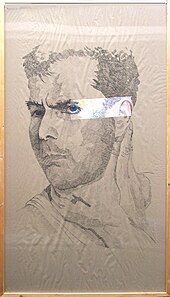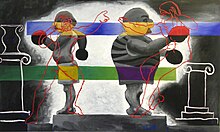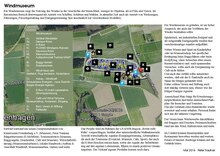Peter Trautner
Peter Trautner (born November 8, 1951 in Essen - † March 23, 2017 ) was a German artist .
Life
The childhood was marked by the musical instrument trade of the grandmother in Essen with a grandfather who appeared in cabarets as an art whistle, a mother and two aunts with 4 daughters who had all studied music. Elementary school Essen, Konvikt St. Peter der Franziskaner in Dorsten, various grammar schools in Dorsten, Essen and Hemer due to the move, skilled worker certificate as a machinist, evening school in addition to apprenticeship, technical diploma FOS 12 in Menden, abandoned social work studies in Siegen, community service Protestant church in Dortmund. Toolmaker in Iserlohn, truck driver in the Ruhr area, postman in Hemer, antique manufacturer in Siegen, seasonal worker in the Dortmund zoo, cultural worker in Unna. Self-taught artistic activity, first exhibitions in pubs and cafes.
Politically, Trautner committed first in the Party of Democratic Socialism , which he in the state election in 2000 in the state election district of Unna I ran, but could unite only 0.9% of the votes. In the 2005 state elections , he then ran for the WASG in the Unna II state electoral district and achieved at least 2.6%.
plant
Trautner is a modern artist who trained himself as an autodidact (he also tried out recipes from specialist books by Max Doerner and Wehlte for making paints himself) and absorbs many influences from contemporary artists, but also learns intensively from art history. The painter Uwe Pieper helped with artistic orientation in Siegen and the teacher and artist Willi Kemper in FOS 12 , who also confronted his students with the documentary. After drawing (especially Indian ink, 'infected' by Paul Flora ) and painting in a smaller format, he also designed walls and facades throughout Germany. In Unna, contact with the Unna artist group and the Unna glass artist Wilhelm Buschulte led to the founding of the artist group UN-art in 1981 and with it in changing constellations to exhibitions and actions in Italy, Hungary and the Netherlands. With the first orders, the demands on the artist increased and sculpture and sculpture became part of his work.
- The art historian Andrea Sinzel writes about this under the title: "Materiality - Flexibility - Variation" Art is an object of use of a spiritual nature - with these words the art historian Jean-Christophe Ammann refers to the functionality and practical value of art. Art is therefore an object of life and to that extent a form of individual and public life. Peter Trautner tries to meet this demand for modern art in a very individual way. The spectrum of his work ranges from interior fittings and wall paintings to sculptures made of wood, alabaster, steel and bronze. With regard to this complexity, Trautner's work is closely related to his biographical career. As a trained machine fitter and toolmaker, Trautner finally came to art via the detour of cultural work. If you look at his work as a whole, constancy and variation emerge as fixed design principles - constancy in the area of motifs and symbols, variation in relation to the material artistic process. "
By participating in the Symposium M in Iserlohn in 1996, Trautner acquired knowledge and practice of bronze casting. Here, too, fun and philosophical thinking is practiced in cooperation with international artists and results in Trautner's sculpture of the 2 female Icarus on the diving platform (Ikarussia) , his allusion that emancipation also means being allowed to throw oneself to death like Icarus. This sense of humor and artistic skill was used by Dr. Josef Spiegel as head of the Foundation Künstlerdorf Schöppingen, to have Trautner repaint 50 works from Disney comics that contain art historical allusions. The exhibition "Famous Paintings from Private Ownership in Entenhausen" was originally intended to be shown only once, but is now also touring Europe-wide through museums and is still available to borrow. (Farmer) With an equally humorous approach, Trautner created the 25 objects for "Beautiful Nistening", an exhibition with bird houses, in which allusions to human preferences for animal living (glass house nesting box) and with the bike (real bike) for the citizens of Unna, sports equipment that goes with their secret heraldic animal, the donkey. Contacts with industry enabled the production of the first sculptures made of steel, such as Winnie , which was made from recycled gas and water pipes with a wind-sensitive head and which is now on the Ruhr (Winnie) cycle path in Fröndenberg. Participation in competitions and tenders resulted in the 2003 art prize and acquisitions by the company Keuco (bath wanner) in Hemer.
With the beginning of his work in the field of miniature , a creative epoch begins in which a modern form of miniature is found with different materials and found surfaces. Not only found graphics are 'decorated', but also small self-made objects made of wood or drinks cartons (Packmann) are also designed with miniature painting in addition to their changed shape. Playing card figures have been robbed of their superfluous environment and appear in a completely new story (playing card figure in the forest) .
- The art historian Markus von Hagen from Münster writes: "Peter Trautner often plays with proportions in his pictures, for example when he places small everyday objects in front of large surfaces that often look like excerpts from sky and cloud studies, indicating the widest possible space Such a tension can also be found in his miniatures: Many of them are embodied in the style of medieval book illumination - and at the same time lovingly parodying them on closer inspection - in an ancient text that goes far back in time, for example in an ancient missal manuscript with text or notes, These are not actually illustrative, but ironically superimposed. The miniature, the small object in the sense of a fragment, thus acquires a new independence, a new, also aesthetic value. "
In addition to the more technical term miniature, Peter Trautner deals intensively with winged beings, especially angels and Icarus . In various exhibition architectures he presents angel-like creatures made of bronze, glass, wood and other material in front of webs of fabric and paper with historical appearances of these beings or he presents two aspects of these heavenly creatures in an exhibition, with cartoons of heavenly everyday life being shown in one area, while in the main area the bronze, glass, wooden or objects made of recycled material can be viewed.
- Ameli Gertzen, the pedagogical director of the Kolping-Bildungsstätte Coesfeld writes in the preface to Drengel, Bengel, Quengel and Co. in 2010 : "The artist plays with these beings in his art. Sometimes he doesn't take them so seriously, he asks them human questions, which one should actually not put angels at all because they cannot be grasped with human criteria:
- Where do you put your wings when you want to sleep or take a shower?
- Do you have to practice flying or can you just do it?
- If they fly through a glass, is there a hole left in the glass?
These questions, which sometimes border on naive innocence, have a very deliberate aim; they are supposed to thwart the old familiar view of angels, want to disturb something ironically, thereby wanting to enable new perspectives on these beings, whom we all know as well as they are alien to us. But what / who are they then for us? "
For Trautner, religion plays a role as a world religion in that he considers all religions under a common original desire of people to understand their being and, in a very pragmatic way, turns this into art again and again. For the exhibition in the place of pilgrimage in Telgte with the title> aufkreuzen <he created a bread pan (now in the Museum Heimathaus Münsterland ) with a bread that could correspond in its composition to a Sunday sweet bread in the land of the Hebrews 2000 years ago.
Since Trautner has always been organized in a trade union since his apprenticeship as a locksmith, there was consequently an engagement in political art. Exhibitions in trade union houses particularly pleased the visitors with the revised newspaper pages, whereby existing pictures and headlines are drawn and painted in a new context while maintaining the cheerful character in Trautner's pictures.
Trautner's work with different materials is also typical. Everything new in technology or material is interesting to him at first. As soon as water jet cutting was on the market, the first glass ( angel ) and stone objects were created. From the metal sector, stainless steel ( Ikarus-Mobilé ) and especially the cutting techniques plasma cutting, water jet and laser were interesting at some point . The new printing techniques and their expansion, for example the inkjet printer, brought new manufacturing processes onto the market. Now everything from the construction plan to the trousers ( birch picture dungarees ) can be printed with pictures and there are more and more reprints of painted pictures on the market. In sculpture, acrylates are used as a material for transparent objects, body scanners and robot carvers create rough, lifelike images of things or people, for climbing rocks and stage sets, Acrystal is used as a new material that can replace the previously harmful tissues and liquids in some areas. Trautner can still imagine a competition against a plotter and he still dreams of using laser beams to cut images out of clouds or of giving the moon a new face ( golf on the moon ).
At the same time, Trautner is not only expanding the network of artists with the establishment of the producer gallery Ku7 and the expansion of an old bakery into an KUNST-HOF , a commercial building-like collection of artists, but is also helping in Fröndenberg / Ruhr with the establishment of an art association and organizing sculpture symposiums and summer academies and artist meetings. The 2011 Sculpture Symposium served the application of regenerative energies in and on art objects, as these new technologies will of course find their way into modern art (figure of light). This gave rise to the idea for a river shark that only generates electricity. A small hydropower plant disguised as a shark is supposed to generate electricity by swimming in the Ruhr. For tourists on the cycle path, the result will be readable and the object will be an attractive snapshot ( stream shark ). This object could also serve as a city advertisement and an incentive for employment with alternative technologies. For the newly created LEADER region Börde-meets-Ruhr with Wickede and Ense also on the Ruhr, Trautner designed an exhibition series for the art association Fröndenberg on the subject of water.
His commitment to the new technologies also earned him participation in the> Unprojects <parallel to the Capital of Culture 2010, which was triggered by a private initiative, collected many alternative project ideas and ended with an exhibition in the Architecture Forum in Essen. Trautner presented his "Luftauto", a small telephone booth, air-powered commuter vehicle for the Ruhr region. The latest planning in the framework of the LEADER region is a wind museum, which will consist of vertical rotors, a wind buggy race track, cafe, e-citizen bus charging station and many hands-on activities.
Solo exhibitions
- 1981: Hellweg Museum Unna
- 1990: Club of Intelligence Döbeln
- 1990: E. van Kempen Gallery, Eindhoven (NL)
- 1991: 7 murals for the Kirchentag in the Ruhr area in the Unna district,
- 1998: Kunstverein Werne, (catalog)
- 2001: famous paintings from Entenhausen's private collection (catalog)
- 2004: CulinaDo, Messe Dortmund
- 2004: Katharinen Hospital Unna, Franziskusweg
- 2005: Ikarus, Haldensleben City & Castle
- 2005: cutout, Kamen town hall
- 2005: City Ecological Adventure Path City of Unna (4 sculptures in public space)
- 2006: Engel im Dorf, Unna-Hemmerde (social sculpture with the village)
- 2007: Miniature, Mediengalerie Berlin, (catalog)
- 2010: Engel, Kolping-Bildungsstätte Coesfeld, (2 catalog booklets)
- 2012: Glückstück, Sparkasse Iserlohn
- 2012: artificial, Menden Town Hall Gallery
- 2012: University and State Library, Münster
Group exhibitions
- 1985: Villa Rathgeb, Abano Therme, Italy, artist group UN-art
- 1992: Fiera dei Fiori, Pescia, Italy, artist group UN-art
- 1995: Mildenstein Castle District Museum, Leisnig
- 1999: Ökumenta, eco fair, Hamm in Westphalia
- 2000: Art axis Aisch
- 2003: 50 JA, Museum for Art and Cultural History, Dortmund
- 2005: LünTEC, Technopark Lünen
- 2009: Being human, Kulturforum Kapelle Waltrop
- 2010: Colliery / swimming pool, 2 x cultural capital Waltrop
- 2010: Bazonnale, Weimar
- 2010: Triennial Zeitzeichen-Zeitgleich (BBK), 2007 Unna, 2010 Fröndenberg
- 2010: Unprojects, Architecture Forum Essen
- 2011: Galerie Unkel, Villach (Austria)
- 2011: Nicolaihaus, Unna
- 2012: Liberty-wharf St. Helier, Art House Show, Jersey
- 2013: Wedinghausen Monastery, Arnsberg
- 2014: rearte Gallery, Vienna (Austria)
Scholarships
- 1996: Symposium M, Iserlohn
- 2011: Working grant from the Künstlerdorf Schöppingen Foundation
Art award
- 2000: Honored by the mayor of Unna for services to art.
- 2003: Art Prize from Keuco, Hemer
- 2013: Art Prize 24. Drüggelter Kunststückchen
literature
- Unna Blues - Peter Trautner, sketches and poems, Verlag im Bücherzentrum, Unna, 2008. ISBN 978-3-9809261-6-4 .
- Famous paintings from Entenhausen's private collection Brunsiek / Spiegel / Bitzhenner: Medium Music Books, ISBN 3-9806659-5-X
- Miniature Peter Trautner, DNB 994314434
- Ebert, Helmut: Lexicon of the visual and creative artists in Westphalia-Lippe. Special volume Münster 2006, Trautner, Peter (artist), GND 133164926
- Catalog CAST-ART, Messe Düsseldorf, A. Sutter ISBN 3-87260-137-7
- Catalog 50 JA BBK, Museum for Art & Cultural History Do., ISBN 3-936641-04-8
- Catalog Aisch Art Axis, Art and Sculpture Path , ISBN 3-87191-273-5
- from angel to superman, text: Andrea Sinzel, self-published, DNB 1013050487
- Drengel, Bengel, Quengel & Co., comics, cartoons, caricatures, self-published 2010, DNB 1013049993
- Drengel, Bengel, Quengel & Co., fine arts in general, self-published 2011 DNB 1013050045
- Nature report 14/2010 Jb. Naturförderungsges., District of Unna,
- Int. Sculpture Symposium - Scarecrows & Renewable Energy, self-published 2011,
- Transfer No. 8, Schöppinger Forum d. Art education 2011, ISBN 978-3-937828-25-1
- Wasser.werke, catalog BBK Süd-Westfalen 2012/2013,
- small murders, book with miniatures and short stories, self-published, 2016
- Fröndenberger Visionen, brochure, artistic urban design, self-published, 2016
TV
- Video contribution RAI uno 1985, Regione Padua, Gruppo UN-art al Villa Rathgeb
- Video contribution NDR 2001, famous paintings from Duckburg's private collection ( NDR shooting of Duckburg )
- Local time WDR 2003, BBK-Westfalen - Kunst & Sport, Technopark Bochum
- Local time WDR 2004, CulinaDo Dortmund, red wine painting Peter Trautner
- Local time WDR 2008, Unna-Hemmerde Summer Academy - vacation at Rüschebach
- Local time WDR 2014, local time Dortmund - Rieseneule in Fröndenberg
Web links
Individual evidence
- ↑ Trrauer to Peter Trautner . In: HAWR-Digital . ( hawr-digital.de [accessed on March 27, 2017]).
- ↑ List of applicants for the NRW state elections in 2000, accessed on July 8, 2017.
- ↑ Result of the NRW state elections in 2000, accessed on July 8, 2017.
- ↑ List of applicants for the NRW state elections 2005, accessed on January 16, 2019.
- ↑ Result of the NRW state elections 2005, accessed on January 16, 2019.
- "Gertzen: Drengel, Bengel, Quengel & Co. 2010, foreword"
- “Hagen, from: Miniature. 2009, foreword "
- "Sinzel: vom Engel zum Supermann 1998, pp. 5-11."
- Letter from Paul Flora (draftsman, Austria) after his 85th birthday Letter from Paul Flora (draftsman, Austria)
| personal data | |
|---|---|
| SURNAME | Trautner, Peter |
| BRIEF DESCRIPTION | German artist |
| DATE OF BIRTH | November 8, 1951 |
| PLACE OF BIRTH | eat |
| DATE OF DEATH | 23rd March 2017 |





